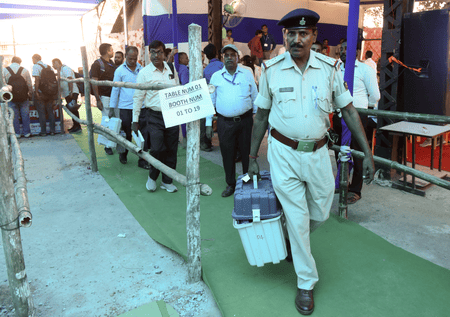
New Delhi, Nov 11 (IANS) Bihar registered an estimated voter turnout of record 67.14 per cent by 5 p.m. on Tuesday in the second and final phase of the Assembly elections.
This round has not only recorded the highest-ever turnout achieved in the state in any Assembly or Lok Sabha elections, but the final number after the completion of the entire process will further spike the total percentage.
The first phase witnessed the highest-ever percentage of electors in any Assembly polling, 2.09 per cent more than the earlier high of 62.57 per cent achieved in 2020.
However, it could not touch the numbers in the 1998 Lok Sabha election when 64.6 per cent of the state's total electors had cast their votes. At least four districts recorded a turnout of over 70 per cent, with electors coming out in large numbers in Kishanganj (76.26 per cent), Katihar (75.23 pe cent), Purnea (73.79 per cent), and Supaul (70.69 per cent) till 5 p.m.
Altogether, the number of seats in the Bihar Legislative Assembly is 243, of which elections have already been held in 121 constituencies on November 6. Counting of votes will take place on November 14.
The second phase covered 122 seats across 20 districts, with 1,302 candidates contesting.
Nearly 3.7 crore voters were eligible to vote, with over 45,399 polling stations set up for this round of polls.
Security was extremely tight, with over four lakh personnel deployed, including paramilitary forces and bomb disposal squads, to ensure smooth polling. The process was held with scrutiny to details following Monday's blast in Delhi.
No major incidents of violence have been reported so far, with 20 districts, including West Champaran, East Champaran, Sitamarhi, Madhubani, Supaul, Araria, Kishanganj, Gaya, Jamui, Aurangabad, Banka, Purnia, Katihar, Bhagalpur, Nawada, Rohtas, Kaimur, Arwal, Jahanabad, and Sheohar.
Of particular importance among the regions that went to polls was Seemanchal, bordering West Bengal and Nepal, comprising a Muslim population far above the state average, a factor that makes its Assembly seats disproportionately important in tight contests.
Though Muslims account for around 17.70 per cent of Bihar's population according to the 2023 caste-based survey data, the community represents an estimated 47 per cent of the population in these parts, playing a decisive role during polls. The region has 24 Assembly constituencies – or roughly 10 per cent of the state’s total seats.
Several political parties in Bihar try to convert Seemanchal's religious and caste loyalties into predictable vote banks, ignoring the poverty, low development indicators, migration-driven livelihoods, and frequent flood-induced distress.
In the 2020 elections, out of the 122 seats in this phase, the ruling National Democratic Alliance (NDA) won 66, giving this round of polling significant weight in determining the overall majority.
Among prominent battles being observed in key constituencies are Chakai, Jamui, Dhamdaha, Chhatapur, Jokihat, among others, where heavyweight candidates from the Janata Dal (United), the Bharatiya Janata Party and its other NDA constituents are pitted against Mahagtahbandhan nominees from the Rashtriya Janata Dal, Congress, and the Left parties.
Also in the fray in some constituencies are candidates representing Asaduddin Owaisi-led All India Majlis-e-Ittehadul Muslimeen (AIMIM), and former poll strategist Prashant Kishor's Jan Suraaj Party.
By 11 a.m., turnout across the state was recorded at 31.38 per cent, with Kishanganj (34.74 per cent) registering the highest, and Madhubani (28.66 per cent) the lowest. By 3 p.m., turnout was reported at 60.40 per cent, reflecting a strong participation again.
